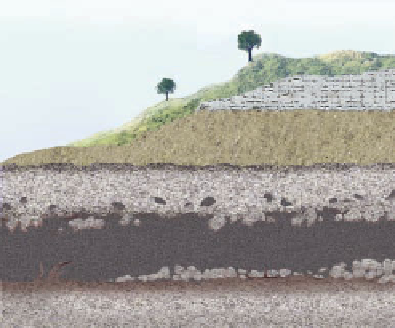Geology Reference
In-Depth Information
◗
Figure 17.4
Differentiating Between a Buried Lava Flow and a Sill In frames
a
and
b
below, the
ages of sedimentary strata are shown by numbering from 1-6, with (1) being the oldest sedimentary
rock layer in each frame, and (6) the youngest. Remember that the lava fl ow took place
during
deposition of an ordinary sedimentary sequence, whereas the sill intruded the sedimentary strata
after
they had accumulated. The notes in both frames highlight the physical features that one would
look for to distinguish between a lava fl ow and a sill, which can look quite similar in an outcrop.
Clasts of
lava may
be present
in the
overlying,
younger
layer
5
Strands and
shreds of
underlying
sedimentary
material may
be in the base
of the flow
4
3
Rubble
zones may
be present
at the top
and bottom
of the flow
Lava flow
Baking zone
at bottom of
flow
A buried lava fl ow has baked underlying
bed 2 when it fl owed over it. Clasts of the lava
were deposited along with other sediments
during deposition of bed 3. The lava fl ow is
younger than bed 2 and older than beds 3, 4,
and 5.
a
2
1
6
5
4
3
Inclusions
of rock from
both layers
above (3)
and below
(2) may exist
in the sill
Baking zones
on both sides
of sill
Sill
2
The rock units above and below the sill have
been baked, indicating that the sill is younger
than beds 2 and 3, but its age relative to beds
4-6 cannot be determined.
b
1
Lava flow
c
This buried lava fl ow in Yellowstone National
Park, Wyoming, displays columnar joining. A
baked zone is present below, and not above, the
igneous structure, indicating that it is a buried
lava fl ow and not a sill.












Search WWH ::

Custom Search